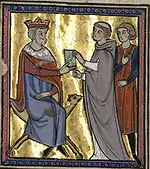| Bertha of Sulzbach | |
|---|---|
| Byzantine Empress Consort | |
| Tenure | 1146 - 1159 |
| Born | c. 1110s |
| Died | 1159 Constantinople |
| Spouse | Manuel I Komnenos |
| Issue | Maria Komnene Anna Komnena |
| Father | Berengar II of Sulzbach |
| Mother | Adelheid of Wolfratshausen |
Bertha of Sulzbach[lower-alpha 1] (1110s – 1159), also known as Irene, was a Byzantine empress by marriage to Byzantine Emperor Manuel I Komnenos.
Life
She was born in Sulzbach, a daughter of Berengar II, Count of Sulzbach (c. 1080 – 3 December 1125) and his second spouse Adelheid of Wolfratshausen.[1] He was one of the rulers who signed the Concordat of Worms.
Empress

Emissaries of the Byzantine emperor John II Komnenos arrived in Germany, seeking an alliance against Roger II of Sicily. To seal the alliance, the emissaries requested that Conrad send a princess of his family to be married to the emperor's son, Manuel. Instead, Conrad selected his sister-in-law, Bertha,[2] and after legally adopting her as his daughter,[3] sent her to the Byzantine Empire escorted by Emicho von Leiningen, the Bishop of Würzburg.
By the time Bertha arrived at the Imperial court in Constantinople, the emperor John was dead, and his son Manuel was now the reigning emperor. Manuel delayed marrying her for three years, until shortly after Epiphany 1146, at which point she became empress and was renamed "Irene/Eireni" (Εἰρήνη),[3] a common name for foreign-born princesses. As an introduction for her to the Hellenic culture she was marrying into, John Tzetzes wrote his Allegories on the Iliad.
Bertha-Irene was noted for shunning the frivolity of the luxurious Byzantine court; Basil of Ochrid, the archbishop of Thessalonica, praised her for her modesty and piety, and Nicetas Choniates (53sq.) noted that she did not wear face-paint. The patriarch of Constantinople, Cosmas II Atticus, who had been accused of heresy, allegedly cursed Bertha-Ireneʻs womb in 1147 to prevent her bearing a son.
Bertha-Irene died in Constantinople in 1159.[4] Her husband Manuel was described as "roaring like a lion" in grief at her death, despite his infidelities during her lifetime. He remarried, in 1161, to Maria of Antioch.
Issue
She and Manuel had two daughters:
- Maria Comnena (1152–1182), who married Renier of Montferrat[5]
- Anna Comnena (1154–1158)[6]
Notes
- ↑ In German: Bertha von Sulzbach; In Greek Βέρθα του Ζούλτσμπαχ, Bertha tou Zoultsbach
References
- ↑ Chalandon 1923, p. 360.
- ↑ Magdalino 1993, p. 38.
- 1 2 Freed 2016, p. 48.
- ↑ Hodgson 2007, p. 88.
- ↑ Magdalino 1993, p. table 1.
- ↑ Magdalino 1993, p. 243.
Sources
- Chalandon, Ferdinand (1923). "The Later Comneni". In Tanner, J.R.; Previte-Orton, C.W.; Brooke, Z.N. (eds.). The Cambridge Medieval History:The Eastern Roman Empire. Vol. IV. The Macmillan Company.
- Freed, John B. (2016). Frederick Barbarossa: The Prince and the Myth. Yale University Press.
- Hodgson, Natasha R. (2007). Women, Crusading and the Holy Land in Historical Narrative. The Boydell Press.
- Magdalino, Paul (1993). The Empire of Manuel I Komnenos, 1143-1180. Cambridge University Press.
- Otto of Freising, Deeds of Frederick Barbarossa
- Choniates, Nicetas, Historia, ed. J.-L. Van Dieten, 2 vols., Berlin and New York, 1975; trans. as O City of Byzantium, Annals of Niketas Choniates, by H.J. Magoulias, Detroit; Wayne State University Press, 1984.
- Garland, Lynda. Byzantine Empresses, 1999
- Garland, Lynda, & Stone, Andrew, "Bertha-Irene, first wife of Manuel I Comnenus", De Imperatoribus Romanis (external link)